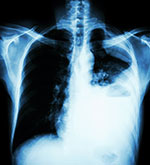Health Effects of Asbestos
Asbestos is a dangerous substance and should be avoided. But people who have contact with asbestos do not always develop health problems. The risk of disease depends on many factors:
- How much asbestos is in the air
- How often and for how long exposure occurs
- How much time has passed since exposure began
- Whether the person already has lung or breathing conditions and
- Whether the person smokes tobacco
Asbestos-Related Diseases
Breathing asbestos can cause tiny asbestos fibers to get stuck in the lungs and irritate lung tissues.

Scientific studies have shown that the following non-cancer diseases can be caused by breathing asbestos:
- Asbestosis is scarring in the lungs caused by breathing asbestos fibers. Oxygen and carbon dioxide do not pass in and out of scarred lungs easily, so breathing becomes harder. Asbestosis usually occurs in people who have had very high exposures over a long time, but years may pass before any symptoms appear.
- Pleural disease is a non-cancerous lung condition that causes changes in the membrane surrounding the lungs and chest cavity (pleura). The membrane may become thicker throughout (diffuse pleural thickening) or in isolated areas (pleural plaques), or fluid may build up around the lungs (known as a pleural effusion). Not everyone with pleural changes will have problems breathing, but some may have less efficient lung function.
Asbestos exposure also increases the risk of developing certain cancers:

Lung cancer is a malignant tumor that invades and blocks the lung’s air passages. Smoking tobacco combined with asbestos exposure greatly increases the chance of developing lung cancer.
- Mesothelioma, is a rare cancer of the membrane that covers the lungs and chest cavity (pleura), the membrane lining the abdominal cavity (peritoneum), or membranes surrounding other internal organs. Signs of mesothelioma may not appear until 30 to 40 years after exposure to asbestos.
In addition to lung cancer and mesothelioma, asbestos exposure can also cause cancer of the larynx and ovary. Current evidence also suggests asbestos exposure may cause cancer of the pharynx, stomach, and colorectum.
Advice for people concerned about asbestos exposure

People concerned about asbestos exposure should visit their doctor or other medical provider. Based on the person’s detailed exposure and medical history and a physical exam, the doctor will decide if additional testing is needed.
After exposure occurs, asbestos can’t be removed from the lungs. Preventing further harm to the respiratory system can lower the chances of disease developing or slow down progress of an existing disease. Preventive care guidelines related to asbestos exposure include
- Having regular medical exams
- Getting regular vaccinations against flu and pneumococcal pneumonia
- Quitting smoking
- Avoiding further asbestos exposure